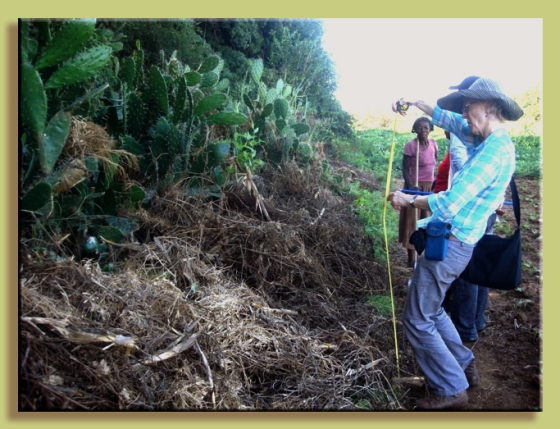Scientists and Research at Berenty |

Berenty researcher measuring flood levels © photo by A Jolly
Research at Berenty has overwhelmingly concentrated on lemurs. The reserve has been protected for seventy years so animals are not afraid of humans. This makes it an ideal site for the study of lemur social behaviour. The five-fold gradient in population density from front to gallery forest to dry scrub offers fascinating comparisons of behaviour in differing environments. The rise of the introduced population of brown lemurs raises both theoretical and ethical dilemmas: what to do when an alien invader is a lemur? Berenty is a forest fragment, and always was, because gallery forests grow naturally as fragments on favourable river bends. It presumably has always been a source population in a sparser landscape, for instance for the colony of fruit bats. Over the decades its plant communities have become dryer, with invasion of alien species. We do not know how much change is due to natural succession, to overgrazing, or to drying of the river itself from deforestation in the headwaters.
The de Heaulme family have welcomed scientists ever since the 1960's. To apply for research at Berenty, you should contact one of the senior scientists who already work there. New projects are welcome. However, accommodation is very limited, often booked months in advance. Senior scientists who wish tourist accommodation are now expected to pay at tourist prices and to book via the website www.madagascar-resorts.com. Make sure you get an answer specifying the room and dates—scientists are sometimes asked to move to make room for "real" clients. There are seven places in the three-house complex called Naturaliste where scientists and students can cook their own meals on minimal budgets, with free lodging and transport provided by the de Heaulmes.
To apply either as a research scientist or as a student, write a one page letter in French to Mme Claire FOULON, clairefoulon1@gmail.com, with a copy to Claire Foulon, Berenty Reserve, Hotel le Dauphin, BP 54, Fort Dauphin. In this letter outline your research project, whom, if anyone, you are working with, and the dates of your proposed stay at Berenty. The dates should be as precise as possible, and if they change, let Mme Foulon know.
When you arrive in Fort Dauphin, go to the Hotel le Dauphin, and from there to the de Heaulme offices. When Mme Foulon or another person gives you authorization, you may be lucky to have a free ride in a tourist buses for the 70 km out to the reserve. More often you need to arrange and pay for a car, especially if on a tight schedule.
Scientists - Research Interests & Contact Details |
Scientists who have recently worked in the reserve include:
|
|---|
_MASTimg_BreakfastMale_(DC).jpg)
_MASTimg_BerentyWebsiteMasthead.jpg)




